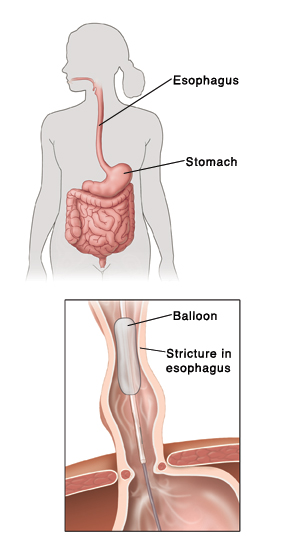Esophageal Dilation
An esophageal dilation is a procedure used to widen a narrowed section of your esophagus. This is the tube that leads from your throat to your stomach. Narrowing (stricture) of the esophagus can cause problems. These include trouble swallowing. The information below explains what to expect with the esophageal dilation procedure.
Why esophageal dilation is needed
Several problems can be treated with esophageal dilation. They include:
-
Esophageal stricture. This is caused by reflux esophagitis. With this problem, the esophagus is irritated by acid reflux (heartburn). This occurs when acid from your stomach flows back up into the esophagus. Stomach acid damages the lining of the esophagus. This leads to a buildup of scar tissue. As a result, the esophagus is narrowed.
-
Schatzki’s ring. This is an abnormal ring of tissue. It forms where the esophagus meets the stomach. It can cause trouble swallowing. It can also cause food to get stuck in the esophagus. The cause of this condition is not known.
-
Achalasia. This condition stops food and liquids from moving into your stomach from the esophagus. It affects the lower esophageal sphincter (LES). The LES is a muscular ring that opens (relaxes) when you swallow. With achalasia, the LES does not relax. This condition can also cause problems with peristalsis, which is the normal muscular action of the esophagus that moves food into the stomach.
-
Eosinophilic esophagitis. This is a redness and swelling (inflammation) in the esophagus. It's caused by an environmental trigger, such as a food allergy. It can lead to pain, trouble swallowing, and strictures.
-
Less common causes of stricture. Other causes of stricture include radiation treatment and cancer.
Before you have esophageal dilation
-
Tell your health care provider about any medicines you take. This includes prescription medicines, over-the-counter medicines, herbs, vitamins, and other supplements. Be sure to mention aspirin or any blood thinners you’re taking.
-
Let your provider know if you need to take antibiotics before dental procedures. You may need to take them before esophageal dilation as well.
-
Tell your provider about any health conditions you have, such as heart or lung disease. Also mention any recent illnesses and any allergies to medicines.
-
You’ll need to have an empty stomach for the procedure. Follow your provider’s instructions for not eating and drinking before the procedure.
-
Arrange to have a family member or friend drive you home after the procedure.
During the procedure
 |
| A balloon dilator may be used to widen a stricture in the esophagus. |
-
You may be given local anesthesia to numb your throat. You’ll also likely be given medicine to relax you. Esophageal dilation is an outpatient procedure that takes about 15 minutes. It does not cause trouble breathing.
-
A tube called an endoscope (scope) is used. This is a narrow tube with a tiny light and camera at the end. The scope is inserted through your mouth and into your esophagus. It lets your health care provider see inside your esophagus. To help guide your provider, an imaging method called fluoroscopy may also be used. This creates a moving X-ray image on a computer screen.
-
Next, special tiny tools are carefully guided through your mouth and down into the esophagus. They make the stricture wider and are then removed. Different types of tools are used. The type used depends on the size and cause of the stricture. Types include:
-
Balloon dilator. A tiny, empty balloon is put into the stricture using an endoscope. The balloon is slowly filled with air. The air is removed from the balloon when the stricture is widened to the right size. Balloon dilators are used to treat many types of strictures.
-
Guided wire dilator. A thin wire is eased down the esophagus. A small tube that’s wider on one end is guided down the wire. It's put into the stricture to stretch it. These dilators are used to treat all kinds of strictures.
-
Bougies. These are weighted, cone-shaped tubes. Starting with smaller cones, your health care provider uses increasingly larger cones until the stricture is stretched the right amount. Bougies are often used to treat strictures that are simple (short, straight, and not very narrow).
After the procedure
-
You’ll be watched closely until your health care provider says you’re ready to go home. You’ll need to have a friend or family member drive you home.
-
You may have a sore throat for the rest of the day.
-
You may have pain behind your breastbone for a short time afterward.
-
You can start drinking fluids again after the numbness in your throat goes away. You can resume eating the same day or the next day.
Risks and possible complications
Risks and possible complications of esophageal dilation include:
Follow-up
You may need to have the procedure repeated one or more times. This depends on the cause and extent of the narrowing. Repeat procedures can allow the dilation to take place more slowly. This reduces the risks of the procedure.
If your stricture was caused by reflux esophagitis, you’ll likely need to take medicine to treat that condition. Your health care provider will tell you more.
When to call your doctor
Contact your health care provider or get medical care right away if you have any of the following after the procedure:
-
Fever of 100.4°F (38°C) or higher, or as directed by your provider
-
Chest pain (Call 911.)
-
Trouble swallowing
-
Vomiting blood or material that looks like coffee grounds
-
Bleeding
-
Black, tarry, or bloody stools
© 2000-2025 The StayWell Company, LLC. All rights reserved. This information is not intended as a substitute for professional medical care. Always follow your healthcare professional's instructions.